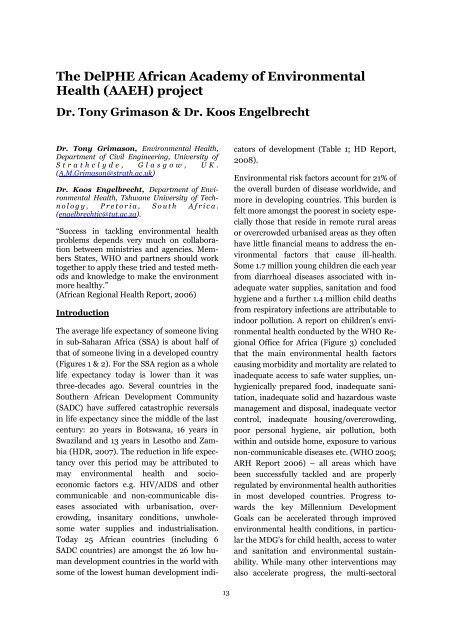ISSN 1683-3805
E&HI Volume 11, No. 1 2009 - International Federation of ...
E&HI Volume 11, No. 1 2009 - International Federation of ...
- No tags were found...
Create successful ePaper yourself
Turn your PDF publications into a flip-book with our unique Google optimized e-Paper software.
The DelPHE African Academy of Environmental<br />
Health (AAEH) project<br />
Dr. Tony Grimason & Dr. Koos Engelbrecht<br />
Dr. Tony Grimason, Environmental Health,<br />
Department of Civil Engineering, University of<br />
S t r a t h c l y d e , G l a s g o w , U K .<br />
(A.M.Grimason@strath.ac.uk)<br />
Dr. Koos Engelbrecht, Department of Environmental<br />
Health, Tshwane University of Techn<br />
o l o g y , P r e t o r i a , S o u t h A f r i c a .<br />
(engelbrechtjc@tut.ac.za).<br />
“Success in tackling environmental health<br />
problems depends very much on collaboration<br />
between ministries and agencies. Members<br />
States, WHO and partners should work<br />
together to apply these tried and tested methods<br />
and knowledge to make the environment<br />
more healthy.”<br />
(African Regional Health Report, 2006)<br />
Introduction<br />
The average life expectancy of someone living<br />
in sub-Saharan Africa (SSA) is about half of<br />
that of someone living in a developed country<br />
(Figures 1 & 2). For the SSA region as a whole<br />
life expectancy today is lower than it was<br />
three-decades ago. Several countries in the<br />
Southern African Development Community<br />
(SADC) have suffered catastrophic reversals<br />
in life expectancy since the middle of the last<br />
century: 20 years in Botswana, 16 years in<br />
Swaziland and 13 years in Lesotho and Zambia<br />
(HDR, 2007). The reduction in life expectancy<br />
over this period may be attributed to<br />
may environmental health and socioeconomic<br />
factors e.g. HIV/AIDS and other<br />
communicable and non-communicable diseases<br />
associated with urbanisation, overcrowding,<br />
insanitary conditions, unwholesome<br />
water supplies and industrialisation.<br />
Today 25 African countries (including 6<br />
SADC countries) are amongst the 26 low human<br />
development countries in the world with<br />
some of the lowest human development indicators<br />
of development (Table 1; HD Report,<br />
2008).<br />
Environmental risk factors account for 21% of<br />
the overall burden of disease worldwide, and<br />
more in developing countries. This burden is<br />
felt more amongst the poorest in society especially<br />
those that reside in remote rural areas<br />
or overcrowded urbanised areas as they often<br />
have little financial means to address the environmental<br />
factors that cause ill-health.<br />
Some 1.7 million young children die each year<br />
from diarrhoeal diseases associated with inadequate<br />
water supplies, sanitation and food<br />
hygiene and a further 1.4 million child deaths<br />
from respiratory infections are attributable to<br />
indoor pollution. A report on children’s environmental<br />
health conducted by the WHO Regional<br />
Office for Africa (Figure 3) concluded<br />
that the main environmental health factors<br />
causing morbidity and mortality are related to<br />
inadequate access to safe water supplies, unhygienically<br />
prepared food, inadequate sanitation,<br />
inadequate solid and hazardous waste<br />
management and disposal, inadequate vector<br />
control, inadequate housing/overcrowding,<br />
poor personal hygiene, air pollution, both<br />
within and outside home, exposure to various<br />
non-communicable diseases etc. (WHO 2005;<br />
ARH Report 2006) – all areas which have<br />
been successfully tackled and are properly<br />
regulated by environmental health authorities<br />
in most developed countries. Progress towards<br />
the key Millennium Development<br />
Goals can be accelerated through improved<br />
environmental health conditions, in particular<br />
the MDG’s for child health, access to water<br />
and sanitation and environmental sustainability.<br />
While many other interventions may<br />
also accelerate progress, the multi-sectoral<br />
13



